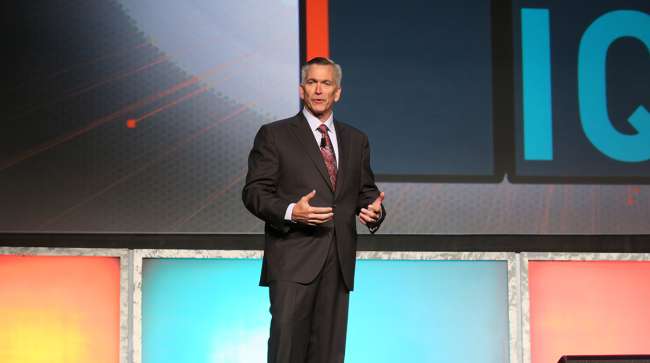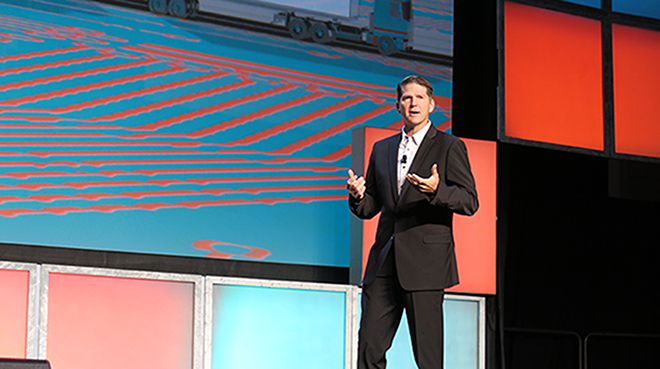Managing Editor, Features and Multimedia
TMW, PeopleNet Say Better Connectivity Needed to Meet Demands of E-Commerce

NASHVILLE, Tenn. — As the growth of e-commerce continues to reshape the supply chain, transportation providers will need to become increasingly connected with their trucks, drivers and freight to keep pace with shippers’ demands, TMW Systems and PeopleNet executives said.
The two Trimble companies, which shared the stage here Aug. 14 at their second annual In.sight user conference, outlined their vision for how trucking can use technology to adapt to an economy where consumers can find and purchase products at any time on their smartphones and expect delivery within a few days or less.
SOFTWARE UNVEILED: TMW debuts software that calculates precise ETA
“No matter the commodity or product category, the on-demand economy is revolutionizing the movement of freight, from raw materials to manufacturer to consumer,” said Dave Wangler, president of TMW. “The winners in this revolution will be those who master the ability to leverage information to increase agility and efficiency.”
.@PeopleNetOnline's Angela Shue: consistent visibility is key to improving final mile delivery. #insightuc pic.twitter.com/8nqY3YV55l — Seth Clevenger (@SethClevenger) August 14, 2017
Carriers and third-party logistics providers must adapt to a “dizzying array” of new distribution and delivery models, he said. At the same time, they face substantial pressure to reduce transportation costs while providing higher levels of service.
“The final mile is becoming the ultimate battleground” as more carriers establish local delivery operations and deploy advanced routing and scheduling systems to succeed in this very competitive space, Wangler said.
Real-time shipment tracking also is becoming a necessity.
“Customers want to know precisely where their freight is at any given moment,” Wangler said.
To help transportation providers respond to these changes, TMW and PeopleNet announced a shared vision for a “connected supply chain” consisting of connected trucks, drivers, freight and business intelligence tools.
That approach also could help the industry better utilize its freight-hauling capacity, which could be strained as the federal electronic logging device mandate goes into effect and the driver shortage worsens.

PeopleNet President Brian McLaughlin. (Seth Clevenger/Transport Topics)
“The alignment of freight capacity right now is inefficient and in many ways is broken,” PeopleNet President Brian McLaughlin said. “We have to fix this problem if we’re going to survive these disruptive forces.”
Future elements of Trimble’s vision for connected freight include trailer and cargo tracking, he said. That will give users full visibility to their trailers and freight in addition to their drivers and trucks.
Trimble also wants to play a greater role in matching trucks with freight. The company is exploring ways to dynamically connect shipper demand with fleets’ available hauling capacity.
McLaughlin said Trimble customers actively manage about 32% of the truckload capacity across North America.
Meanwhile, TMW and PeopleNet have developed business intelligence software designed to make it easier for fleets to digest and utilize the growing amount of data collected by their onboard and back-office systems.
These tools are now effective at predicting what might happen, including which vehicle might break down or which driver could pose a safety risk or might choose to leave the fleet soon, McLaughlin said.
In the future, connected trucks will be the norm, he said.
.@PeopleNetOnline execs discuss #ELDs, predictive analytics, onboard video. #insightuc pic.twitter.com/hrEnBfyW0I — Seth Clevenger (@SethClevenger) August 14, 2017
These trucks will use vehicle-to-infrastructure communications to share information with weigh stations, road signs, smart roads or even smart cities. They may also incorporate vehicle-to-vehicle communications, which could be a core enabler for the move toward autonomous vehicles.
Trimble also is moving to better connect drivers with their fleets through mobile applications.
Another example of that trend is ELDs, which most interstate motor carriers must install in their trucks by Dec. 18 under the federal electronic logging mandate.
McLaughlin announced that PeopleNet has certified its Android system as a compliant ELD and plans to do the same with its other ELD platforms in the near future.
In a separate development, Trimble created two new divisions within its transportation segment — Trimble Transportation Mobility and Trimble Transportation Enterprise.
The Mobility segment includes PeopleNet, Innovated Software Engineering, Trimble Oil & Gas Services, Trimble Final Mile Mobility and several other business units.
The Enterprise division is made up of TMW Systems and ALK Technologies.
Trimble appointed McLaughlin president of the Mobility segment and Wangler president of the Enterprise segment.
The new structure is a formal acknowledgment of the way those companies were already operating.
Rob Painter, Trimble’s chief financial officer, said the transportation segment has been a bright spot for the company.
“Of all the businesses we have in Trimble, this has been the fastest growing part of the portfolio,” he said. “From a business performance standpoint, it’s really exciting to see what this team is doing.”
The global technology company also has large operations in the agriculture and construction sectors.
Trimble began its push into the North American trucking industry with its acquisition of PeopleNet in 2011, followed by TMW and ALK in 2012. In one of its more recent moves, Trimble acquired ISE, a supplier of telematics and electronic logging technology, in June.
Moving forward, Trimble continues to evaluate potential acquisition targets.
“It remains part of the strategy,” Wangler said.


